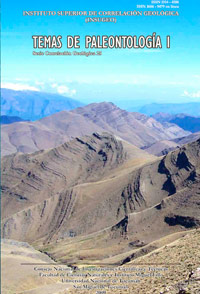Serie Correlación Geológica 25
Microfloras ordovícicas en Sierra de Zenta, Cordillera Oriental Argentina
Descargar trabajo en formato PDFResumen
MICROFLORAS ORDOVÍCICAS EN LA SIERRA DE ZENTA, CORDILLERA ORIENTAL ARGENTINA. En este trabajo se presenta un estudio integrado de las microfloras ordovícicas registradas en la Sierra de Zenta, NW Argentina (provincias de Jujuy y Salta), realizado a partir del análisis sistemático de palinomorfos, principalmente acritarcos y con el aporte de otros grupos como algas prasinofíceas, quitinozoos y criptosporas. La Sierra de Zenta está localizada en una zona transicional entre la Cordillera Oriental y las Sierras Subandinas, mostrando características comunes con ambas provincias geológicas. El sector norte de la sierra presenta características similares a la Cordillera Oriental, donde se identificaron las formaciones Santa Rosita y Acoite (Grupo Santa Victoria). Mientras que el sector centro y sur de la sierra se observó similitudes con las Sierras Subandinas, aunque las unidades se identificaron informalmente como Unidades Formacionales. Se describen dos perfiles geológicos, uno continuo en el sector norte, en Abra de Zenta – Abra Límite, y otro representado por un perfil integrado, descripto mediante cuatro perfiles parciales y relevado en el sector central de la sierra, en Abra Buey Ojo – Laguna Verde. En base al registro de acritarcos se definieron cinco asociaciones palinológicas informales (ASZ) cuyas edades fueron asignadas según la distribución temporal de los taxones componentes. Estas asociaciones fueron comparadas con las de otras secuencias ordovícicas de Argentina y diversas regiones del mundo, estableciendo correlaciones parciales bioestratigráficas y paleogeográficas.
Abstract
ORDOVICIAN MICROFLORAS OF THE SIERRA DE ZENTA, CORDILLERA ORIENTAL ARGENTINA. This work presents the first integrated research on the Ordovician microfloras recorded in the Sierra de Zenta, NW Argentina (Jujuy and Salta provinces), and was carried out on the basis of systematic analysis of palynomorphs, mainly acritarchs. The Sierra de Zenta is located on a transitional zone between the Cordillera Oriental and the Sierras Subandinas, sharing common characters to with both geological provinces. The northern sector of the Sierra displays similar characters to the Cordillera Oriental, with the presence of the Santa Rosita and Acoite formations (Santa Victoria Group). Although the central and southern sector of the Sierra de Zenta presents a great resemblance to the Sierras Subandinas, there is not a perfect match on the stratigrahy of their Ordovician units. Two geological profiles are described, a continuous one in the northern sector of the Abra de Zenta – Abra Límite, and another that is represented by an integrated section relevated in the central part of the sierra, between the Abra Buey Ojo – Laguna Verde. The last stratigraphical sector is composed by four partial sections. In the palynological samples the acritarchs are dominant elements, while prasinophyte, chitinozoans and cryptospores represent minor escorting microfossils. Based on acritarchs records, five informal associations were defined whose ages were assigned according to the chronostratigraphical distribution of the taxones components (ASZ). These associations are compared to other Ordovician sequences of Argentina and diverse regions of the world, establishing some partial bioestratigraphical and paleogeographical correlations.






